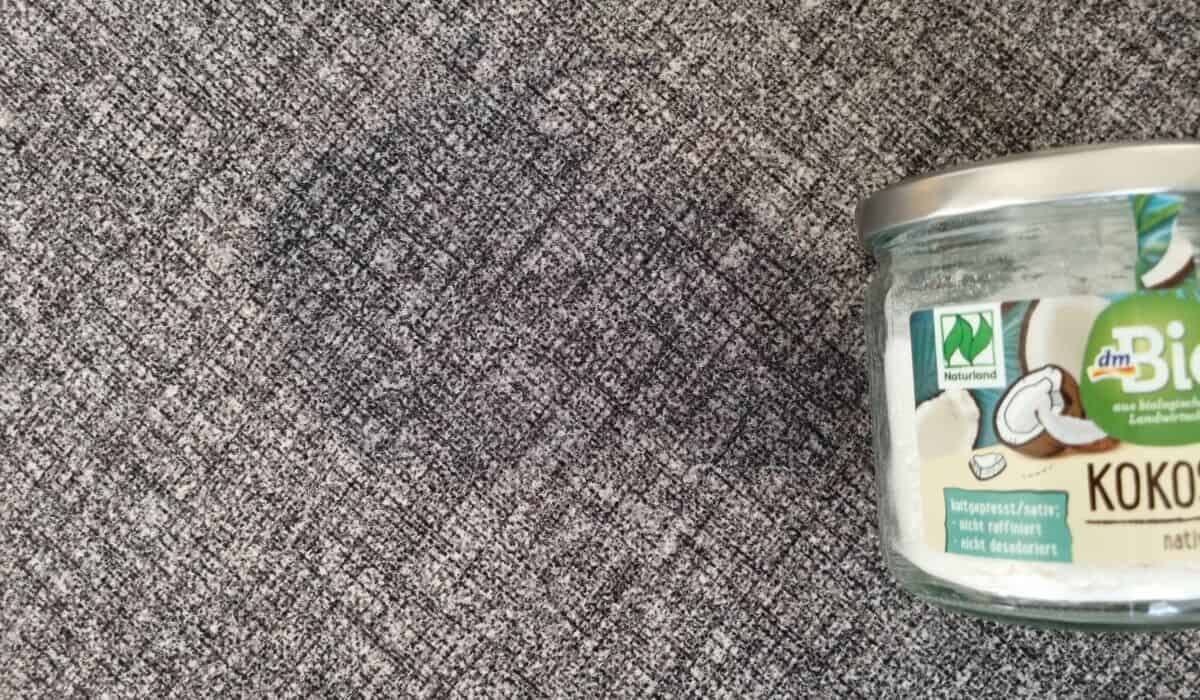The short and direct answer to this question is yes. Coconut oil can cause stains on couches and other pieces of furniture, especially if it is not cleaned up promptly, and properly, and depends on the type of fabric affected. Coconut oil is a natural product, and as such, it can vary in terms of how it will interact with different materials. In some cases, coconut oil may cause a couch or piece of furniture to become stained because of its natural oils. However, in other cases, the oil may simply be absorbed into certain types of fabric without leaving any trace.
How does coconut oil stain furniture?
Coconut oil can stain furniture because it is a natural product that contains oils. There are a few reasons why natural products containing oils can stain fabric.
First, the oil can seep into the fabric and cause discoloration. That color change could prove to be permanent if not attended to promptly.
Also, the oil can interact with other chemicals in the fabric, such as dyes, and cause a reaction that results in a stain. This follows along the lines of the first response, but it is important to note the relationship between coconut oil (natural oils) and certain types of dyes used in furniture.
Make sure you are aware of the chemicals used to create the dye, and from there, understand how coconut oil, and other natural oils, react to those chemicals.
Finally, the oil can simply sit on the surface of the fabric and attract dirt, which can then lead to a stain if left alone for prolonged periods. Dirt and debris can stain fabric if left alone and not cleaned immediately. Dirt and debris stains are almost impossible to clean without just simply replacing the affected area.
What types of furniture fabric will coconut oil stain?
Coconut oil is known to stain a variety of different types of furniture fabric. This includes both natural and synthetic fabrics. Natural fabrics, such as cotton and linen, will absorb oil more easily than synthetic fabrics, such as polyester and nylon, so be extra careful around these fabrics because they are much more stain prone.
With that being said, some synthetic fabrics that may be stained by coconut oil are polyester, nylon, and acrylic. Also, coconut oil has been known to cause discoloration on both light-colored and dark-colored fabrics, but may not show as much with certain colors.
If you are worried about your furniture fabric becoming stained by coconut oil, you can always opt to use a furniture protectant to help prevent the oil from getting on and staining the fabric in the first place.
How do you get coconut oil out of couch and furniture?
There are a few different ways that you can remove coconut oil stains from furniture, and the best method will depend on the type of fabric or material that is stained as well as how long it has been since the coconut oil has been introduced to the fabric.
If the stain is fresh, you can try blotting it with a clean cloth or sponge to absorb as much of the oil as possible before getting into the other measures.
You can also try using a mild detergent or soap to help break down the oil, and then rinse the area with clean water. If the stain is resistant to cleaning, you may need to use a more powerful cleanser, such as white vinegar or rubbing alcohol.
You can also mix baking soda and water to make a paste that may be applied to the spill and allowed to sit for a few minutes before being wiped away.
Whatever method you use, be sure to test it on a small, hidden area of the fabric first to make sure it won’t permanently damage or discolor the material.
I recommend that you try the dry cloth method first, then a wet cloth. After that, try adding dish soap, and if all else fails, white vinegar and water should do the trick. If the stain is still present after trying these home remedies, you may need to try one of the many chemical-based stain remover products on the market today.
What are some products to get coconut oil stains out of furniture?
If the stain persists after exhausting all of the home remedies detailed above, there are several products available to remove coconut oil stains from furniture. Some of these products are:
–Bissell Pet Stain & Odor Eliminator
If the stain persists, after using one or all of these products, you may need to call a professional upholstery or furniture cleaner.
What is coconut oil and how is it made?
Coconut oil is a type of vegetable oil that is derived from the flesh of coconuts. It is made by pressing the oil from the coconut meat, and it has several uses, both culinary and cosmetic. Coconut oil is also high in saturated fat, which has led to some controversy around its health benefits. However, coconut oil is still a popular ingredient in many recipes and products.
Coconut oil is a versatile ingredient that can be used in both sweet and savory dishes. It has a mild flavor that goes well with many different flavors, and it can be used as a substitute for other oils in cooking. Coconut oil is also popular in baked goods because it helps to create a light and fluffy texture.
Coconut oil is also used in cosmetics and skincare products. It is a popular ingredient in moisturizers because it is hydrating and helps to protect the skin from sun damage. Coconut oil can also be used to reduce inflammation and treat acne.
Consclusion
So there you have it, many different ways, both natural and formulaic, to get coconut oil from fabric sofa and other pieces of furniture. By using these methods, your furniture will be looking brand new and at its best again in no time at all. No matter what method you choose, make sure to always be aware of how it will affect your specific furniture type before applying, and always test in a small, hidden area first!

